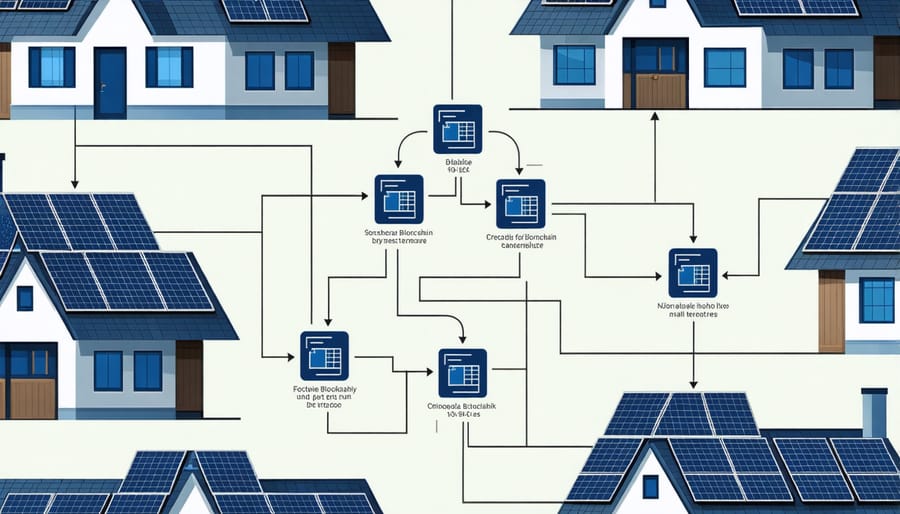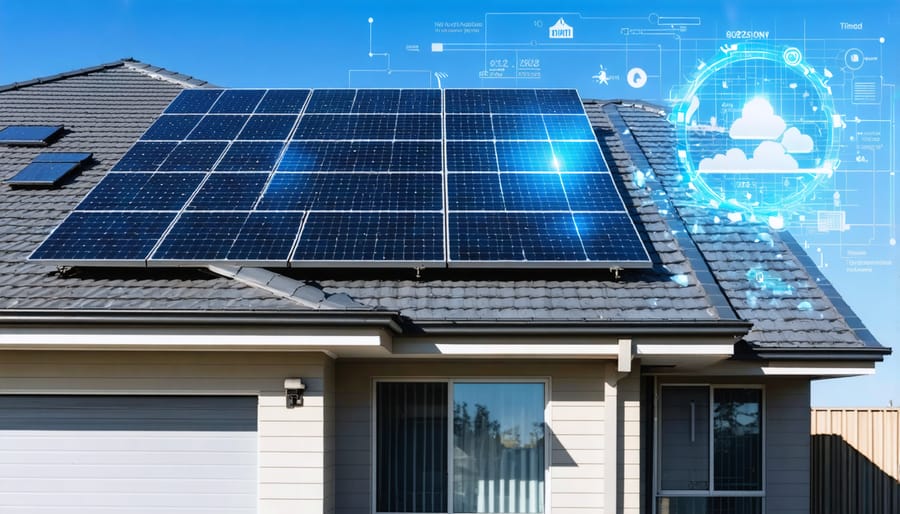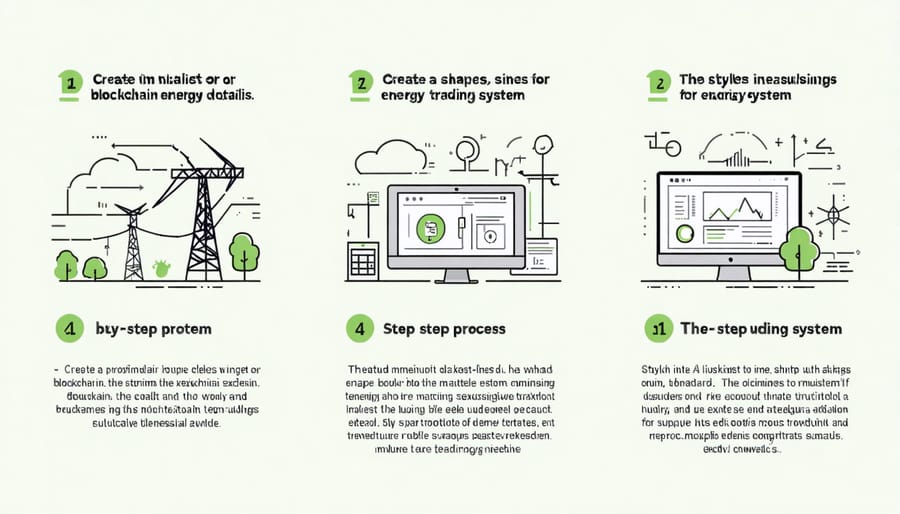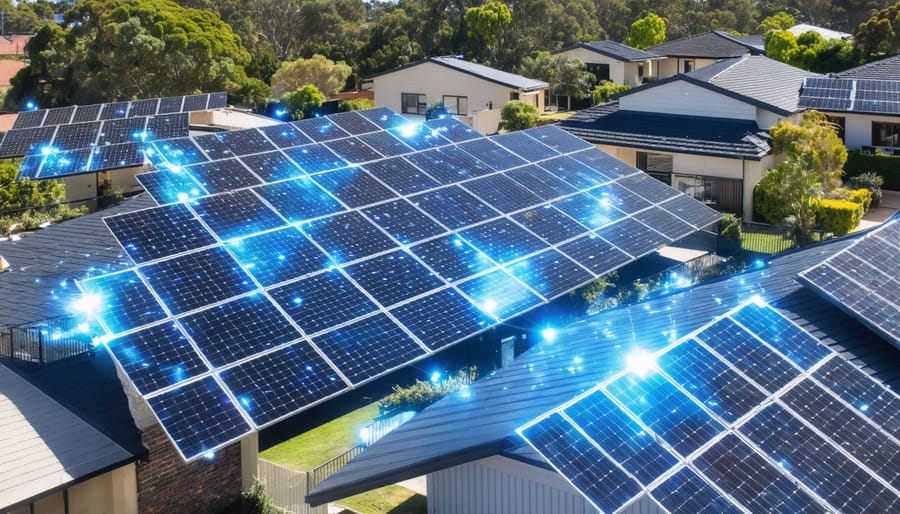Blockchain technology is revolutionizing Australia’s energy sector, creating a secure, transparent marketplace where households and businesses can trade renewable energy directly with each other. This peer-to-peer energy trading system eliminates intermediaries, reduces costs, and accelerates the transition to sustainable power sources. In Western Australia alone, blockchain-enabled microgrids have already helped communities reduce energy costs by up to 30% while increasing renewable energy usage.
The technology’s ability to record and verify energy transactions in real-time is transforming how we manage power distribution. Smart contracts automatically execute trades when conditions are met, ensuring fair pricing and efficient resource allocation. From solar-powered neighborhoods in Sydney to wind farms in Victoria, blockchain platforms are enabling communities to take control of their energy future.
As climate change demands urgent action, blockchain offers a practical solution for democratizing energy markets and accelerating renewable adoption. Its transparent, tamper-proof ledger system provides the foundation for a more sustainable and equitable energy ecosystem, where every kilowatt of clean power can be tracked, traded, and validated with unprecedented accuracy.
How Blockchain Revolutionizes Energy Trading
Smart Contracts: Automating Energy Transactions
Smart contracts are revolutionizing how energy is traded and managed across Australia’s smart energy systems. These self-executing contracts, powered by blockchain technology, automatically facilitate, verify, and enforce energy transactions without the need for intermediaries.
Think of smart contracts as digital agreements that spring into action when specific conditions are met. For example, when your solar panels generate excess electricity, a smart contract can automatically sell this surplus to neighbours at pre-agreed rates. The payment is processed instantly, and the energy transfer is recorded securely on the blockchain.
This automation brings remarkable benefits to energy trading. It reduces transaction costs, eliminates paperwork, and ensures transparent, tamper-proof records. For Australian communities embracing renewable energy, smart contracts enable peer-to-peer energy trading within microgrids, fostering energy independence and sustainability.
Local initiatives are already showing promising results. In Perth’s Power Ledger project, residents use smart contracts to trade solar energy directly with their neighbours, creating a more resilient and efficient energy marketplace while reducing reliance on traditional power grids.
Peer-to-Peer Energy Markets
Blockchain technology is revolutionising the way Australians buy and sell energy, creating neighbourhood marketplaces where solar panel owners can trade excess power directly with their neighbours. This peer-to-peer system eliminates the middleman, allowing households to set their own prices and choose their preferred energy sources.
In communities like Power Ledger’s trial in Fremantle, residents are already experiencing the benefits of direct energy trading. Solar-equipped homes can earn better returns on their investment by selling surplus energy to nearby consumers at competitive rates, while buyers enjoy access to locally-produced renewable energy at prices often lower than traditional retailers.
The system works through smart contracts that automatically match buyers with sellers and handle payments securely. When your neighbour’s solar panels generate excess electricity, you can purchase it instantly through a user-friendly mobile app, with transactions recorded transparently on the blockchain.
This democratic approach to energy trading is particularly valuable in remote Australian communities, where direct trading can enhance grid resilience and promote energy independence. As more communities adopt these systems, we’re seeing the emergence of self-sustaining energy ecosystems that benefit both the environment and local economies.


Real Benefits for Australian Energy Users
Lower Energy Costs Through Direct Trading
One of the most compelling advantages of blockchain technology in the energy sector is its ability to significantly reduce costs through peer-to-peer trading. By removing traditional intermediaries from energy transactions, blockchain creates a direct pathway between producers and consumers, leading to substantial savings for both parties.
Consider a solar-powered home in suburban Melbourne. Previously, excess energy would be sold back to the grid at rates determined by large utility companies. Now, with blockchain-enabled trading platforms, that same household can sell directly to neighbours at mutually beneficial prices. This direct trading approach typically results in 15-30% lower energy costs for buyers and better returns for sellers.
The efficiency gains extend beyond simple cost reduction. Smart contracts automatically execute trades when predetermined conditions are met, eliminating paperwork and administrative overhead. Settlement times for energy transactions drop from days to minutes, and the transparent nature of blockchain technology means all parties can verify transactions instantly.
Australian communities implementing blockchain-based energy trading have reported significant benefits. For example, several microgrids in Western Australia have demonstrated how removing intermediaries can reduce energy costs by up to 25% while maintaining system reliability. The automated nature of these systems also means lower operational costs, with savings passed directly to consumers.
This direct trading model particularly benefits remote communities, where traditional energy infrastructure and intermediaries often add substantial costs to energy delivery.
Enhanced Grid Stability and Security
Blockchain technology is revolutionizing how we manage and secure our energy networks, bringing unprecedented stability to Australia’s power grid. By creating an immutable record of energy transactions and distribution patterns, blockchain enables real-time monitoring and automated responses to fluctuations in supply and demand. This technology works alongside other grid stability innovations to create a more resilient energy infrastructure.
The decentralized nature of blockchain provides multiple layers of security against cyber threats and system failures. Unlike traditional centralized systems, where a single point of failure can disrupt entire networks, blockchain distributes control across multiple nodes. This means if one part of the system is compromised, the rest continues to function normally, ensuring continuous power supply to homes and businesses.
In regional communities, blockchain-enabled microgrids are already demonstrating impressive results. The Western Australian town of Mullewa, for instance, has reduced power outages by 45% since implementing blockchain-based grid management. The system automatically detects and responds to supply fluctuations, maintaining stable power delivery even during peak demand periods.
For renewable energy integration, blockchain’s smart contracts enable instantaneous switching between different power sources, ensuring consistent supply regardless of weather conditions. This capability is particularly valuable for maintaining grid stability as Australia transitions towards its renewable energy targets.
Australian Success Stories
Power Ledger’s Journey in Perth
Power Ledger, born in the sun-soaked streets of Perth, has emerged as Australia’s pioneering force in blockchain-based energy trading. Since its launch in 2016, this innovative platform has transformed the way Western Australians think about and trade renewable energy, particularly in the bustling suburbs of Fremantle and White Gum Valley.
The company’s flagship project in Perth demonstrates how blockchain technology can democratize energy trading. Residents with solar panels can sell their excess power directly to neighbors, creating a local energy marketplace that benefits both buyers and sellers. This peer-to-peer trading system has reduced electricity costs for participants by up to 20% while providing solar panel owners with better returns on their investment.
In 2019, Power Ledger partnered with Synergy and Western Power to launch RENeW Nexus, a groundbreaking trial in Fremantle involving 40 households. The project proved that blockchain technology could successfully track energy transactions in real-time, ensuring transparent and accurate settlements between participants.
What sets Power Ledger apart is its use of two tokens: POWR for accessing the platform and Sparkz for energy trading. This dual-token system has made energy trading more accessible to everyday Australians while maintaining the security and efficiency of blockchain technology.
The success in Perth has catalyzed Power Ledger’s expansion across Australia and internationally, showcasing how local innovation can drive global change in renewable energy adoption.
Community Microgrids Using Blockchain
Community microgrids are revolutionizing how neighborhoods share and trade energy, with blockchain technology serving as the backbone for these innovative systems. In Byron Bay, New South Wales, a pioneering project has enabled 50 households to trade excess solar power directly with their neighbors, cutting energy costs by up to 40% while strengthening community bonds.
The system works through smart contracts that automatically execute trades when one household has surplus energy and another needs it. Combined with AI-powered grid management, these microgrids ensure optimal distribution and pricing throughout the day.
In Melbourne’s northern suburbs, another successful implementation has created a self-sustaining energy ecosystem where 200 homes participate in peer-to-peer trading. The blockchain platform provides complete transparency, allowing residents to track their energy production, consumption, and trading history in real-time through a user-friendly mobile app.
These community initiatives are particularly valuable during peak demand periods and emergencies. When the main grid faces stress, these microgrids can operate independently, ensuring continuous power supply to participating households. The success of these projects has inspired similar initiatives across regional Australia, with communities in Queensland and Western Australia developing their own blockchain-based energy trading networks.
Getting Started with Blockchain Energy Trading
Required Technology and Setup
To participate in blockchain-based energy systems, you’ll need several key components working together. The foundation starts with a smart meter capable of real-time energy monitoring and data transmission. These modern meters, increasingly common across Australia, are essential for tracking energy production and consumption accurately.
A stable internet connection is crucial, as blockchain systems rely on continuous connectivity to validate and record transactions. You’ll also need a digital wallet compatible with energy-focused blockchain platforms, which serves as your account for trading energy credits and managing transactions.
For energy producers, such as those with solar panels or wind turbines, a grid-tie inverter with smart capabilities is necessary. This equipment enables seamless integration with the energy grid modernization efforts while maintaining secure communication with the blockchain network.
The software requirements include a user-friendly interface for monitoring energy flows and managing transactions. Most platforms offer mobile apps and web portals that make it easy to track your energy production, consumption, and trading activities in real-time.
For businesses and larger installations, additional hardware such as energy management systems (EMS) might be necessary. These systems help optimize energy use and automate trading decisions based on pre-set parameters.
Importantly, you don’t need to understand the complex technical aspects of blockchain to participate. Most systems are designed with user-friendly interfaces that handle the underlying technology automatically, making it accessible for everyone from homeowners to large-scale energy producers.

Joining Energy Trading Networks
Connecting with blockchain energy networks is becoming increasingly accessible for Australian households and businesses. To get started, you’ll first need to identify the active platforms in your area. Major networks like Power Ledger and LO3 Energy have established presence in various Australian cities, making them excellent entry points for newcomers.
The first step is to check if your energy retailer has partnerships with blockchain platforms. Many Australian utilities now offer blockchain-enabled trading options as part of their service packages. If they do, joining can be as simple as opting into the program through your existing account.
For independent entry, you’ll need to:
1. Install a smart meter if you haven’t already
2. Register with a blockchain energy platform
3. Set up a digital wallet for energy trading
4. Connect your system to the platform’s network
5. Complete the verification process
Most platforms offer user-friendly mobile apps that walk you through the setup process. You’ll need to provide basic information about your energy system, including generation capacity if you have solar panels, and your consumption patterns.
The verification process typically takes 1-2 business days, after which you can start trading energy with other participants. Many networks offer practice modes where you can learn the trading mechanics without risking real transactions.
For businesses and larger organizations, platforms usually provide dedicated onboarding support and additional features like automated trading and detailed analytics. Some networks also offer community groups where you can connect with other participants, share experiences, and learn best practices for maximizing your trading benefits.
Remember to review the platform’s terms, fees, and security measures before joining. Many successful participants start small and gradually increase their trading activity as they become more comfortable with the system.
The transformative potential of blockchain technology in the energy sector represents a pivotal shift in how we think about and manage our energy future. As Australia continues its journey toward a more sustainable energy landscape, blockchain offers the tools we need to create a more efficient, transparent, and democratic energy market.
By enabling peer-to-peer energy trading, automated smart contracts, and real-time monitoring of energy consumption and generation, blockchain technology is helping to democratise energy markets and empower consumers. Communities across Australia are already witnessing the benefits, from reduced energy costs to increased renewable energy adoption and greater grid stability.
The time to embrace this technology is now. Whether you’re a homeowner looking to participate in local energy trading, a business seeking to optimize energy costs, or a policymaker working to create a more sustainable future, blockchain solutions offer practical pathways forward. Start by exploring pilot programs in your area, connecting with local energy initiatives, or investigating how your organization can implement blockchain-based energy solutions.
Remember, every step toward adopting blockchain technology in energy trading contributes to a larger movement – one that’s creating a more sustainable, efficient, and equitable energy future for all Australians. The technology is ready, the benefits are clear, and the opportunity to participate in this energy revolution is at hand. Let’s work together to build a smarter, cleaner energy system for generations to come.

